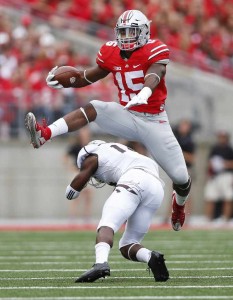The NFL combine is over and it cemented the already pervasive theory that this is a mediocre draft class. There are a couple of players that appear to be something special, but the draft is not particularly deep and it is suspiciously devoid of anyone worthy of being chosen number one overall. In a few years there will without a doubt be a couple of stars that were drafted in 2016, but there may be a lot of teams looking to trade back in exchange for future picks. With that being said, here are the top two prospects at each offensive position post-combine.
Quarterback:
Carson Wentz North Dakota State
He does not come from a big time program, but Wentz has the size and tools that coaches look for in an NFL quarterback. At 6’5” and 235 lbs, Wentz should be able to hold up to the physical rigors of an NFL season and he has played under center which will shorten his learning curve. He will benefit from the fact that the second quarterback prospect has scouts concerned over his small hands. Look for Wentz off the board in the top 5 picks (perhaps Cleveland), although he may not play a lot in his first year making him a fairly low value redraft fantasy commodity.
Jared Goff California
Goff has raised some concerns over the size of his hands as mentioned above, but he produced a pristine combine performance which should put him at the number two quarterback spot. Goff looks like he is mentally and physically the most ready to step in and start for an NFL team. While he may not have the highest ceiling in the draft, he will likely reach that ceiling much faster than the other prospects. There is no surefire star quarterback in this draft, but Goff is the most likely to lead a team as a starter from week 1.
Running Back:
Ezekiel Elliott Ohio State

This is probably the least controversial choice out of my entire list as Elliott is basically the consensus number one running back prospect in this draft. Unfortunately for Elliott, that does not mean what it once did as far as draft position. His skill set is electric and there is no question that Elliot can be a workhorse back for an NFL team. He runs with power and decisiveness while still having good enough hands to make some catches out of the backfield. If the right team drafts him, Elliott could be immediate fantasy gold. Fantasy football managers just have to hope that he does not end up in a time-share reminiscent of Melvin Gordon in 2015.
Derrick Henry Alabama
While Ezekiel Elliott will certainly be the first running back drafted, Henry likely helped his own draft stock with a strong combine performance. A very large back at 6’3” and 245 lbs, Henry may not be a three down player. He was not asked to catch the ball much in college, so his hands are difficult to rate. An excellent combination of power and straight line speed, I could see Henry developing into something reminiscent of Brandon Jacobs in his prime. Although his value will be situation-dependent, I could see Henry having fantasy value as a rookie (mainly touchdown dependent).
Second Year Running Back Preview
Wide Receiver:
Laquon Treadwell Mississippi
Treadwell chose not to take part in the 40 yard dash at the combine, likely because he did not want his average speed to hurt his draft stock. Despite choosing not to run, Treadwell still looks like a player with all of the tools to lead a receiving corps. He has decent size and exemplary ball skills, both of which will allow him to beat NFL defenders even if he does not create immense separation. This class of receivers is a bit thin, but Treadwell looks like a fairly safe bet to be a quality receiver at the next level.
Corey Coleman Baylor
There will be some people clamoring for Will Fuller out of Notre Dame following his combine, but Coleman is a more pro-ready receiver. This is despite the fact that Coleman did not run a large route tree in college. He simply has the speed and quickness to be a nightmare for defenders at any level. Coleman has the moves to make even elite defenders miss him once he has the ball in his hands and will be an effective weapon for any team that drafts him. His usage early on could limit his value as a rookie, but Coleman has the potential to develop into a big play guy quickly and never look back.
Tight End:
Hunter Henry Arkansas
This tight end class is not exciting, but Henry is the best available. A solid pass catcher with decent speed for his size, Henry is a nice complementary piece. He won’t be scaring any defenders or burning up the waiver wire in fantasy, but he could develop into a good pro.
Austin Hooper Stanford
Following a long line of productive tight ends to come out of Stanford, Hooper is a nice player as long as he will not be one of the top offensive options. He is a bit lean for an NFL tight end, but has good hands and can be moved around the formation. He will certainly not be the best tight end to come out of Stanford in recent history, but in a couple of years he may be starting for someone.